Published
on 5
Jan 2017
|
All rights reserved.
|
|
|
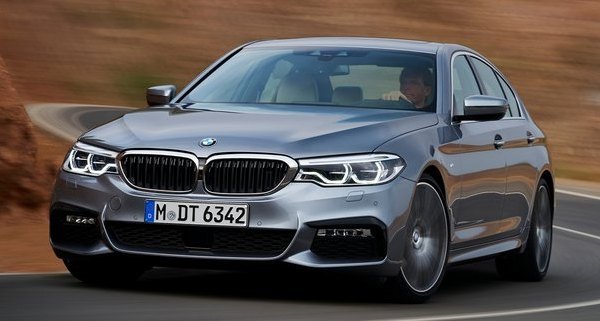 |
|
BMW
has very high expectation for G30, so high that it is adding a third
production site in Austria...
|
|
The
5-Series has
always been an important member of BMW, contributing a substantial part
of sales and profit to the group. The last generation, F10 5-Series was
the most successful of its breed, registering 2.2 million units of
sales during its 7-years lifespan, up from 1.4 million units of E60,
1.47 million units of E39, 1.3 million units of E34, 722,000 units of
E28 and 700,000 units of the original E12. As a result, BMW has very
high expectation for the new G30 model, so high that apart from the
main assembly plant at Dingolfing, Germany, and the Chinese plant at
Shenyang (which produces only LWB version), it is going to add a third
production site at Graz, Austria, in the contract manufacturing plant
of Magna Steyr. Why is it so confident? Hopefully we can find out from
this review.
If you examine its exterior design, you might not get a straightforward
answer. The G30 takes an evolutionary styling approach, unlike the leap
taken by E39 or E60. Much of its genes are shared with the latest
7-Series, especially the front end with a wider version of double
kidney grille. Its new nose gives it a more distinctive character than
the slightly bland nose of the outgoing car. The rest of the car,
however, is barely polished, getting slightly sleeker to achieve lower
aerodynamic drag. The sleekest model is claimed to have a drag
coefficient of 0.22, which should be a new record (both Mercedes
E-class and Audi A4 are good for 0.23). This must thanks to the use of
active shutter grille, underbody sealing and careful management of
turbulence around wheel arches.
 |
|
The
sleekest model is claimed to have a drag coefficient of 0.22, a new
record.
|
|
Size-wise, the new car is also a small evolution from the
outgoing car.
It is just 36mm longer, 6mm wider, 2mm taller and 7mm longer in
wheelbase. As before, the chassis is a mix of high-strength steel and
aluminum. Most of the load-bearing structure is made of high- and
ultra-high-strength steel, but the latter is used more extensively,
especially at the roof rails and front cross member. As before, the
front strut towers are constructed out of aluminum, but now the
longitudinal frames underneath them are also made of aluminum, as are
the rear side members. Meanwhile, the dashboard cross support is made
of magnesium. Although the car is derived from the same platform as the
7-Series, it skips the latter’s carbon-fiber structural parts due to
cost concern. Outside, the bonnet, roof, boot lid and all four doors
are made of aluminum. Overall, the percentage of lightweight materials
has been increased considerably such that the whole car is lighter. A
comparison with our old data will find the new 5-Series models undercut
their corresponding old models by between 55 and 105 kg. Meanwhile,
horizontal comparison will find the BMW is also lighter than its
arch-rival Mercedes E-class and even the all-aluminum Jaguar XF!
Sometimes subtle revisions may result in considerable progress.
At the suspension, the double-wishbone front axle is carried over, but
the rear axle is changed from the compact integral multi-link to a true
5-link design similar to the 7-Series', which should allow finer
tuning. Besides, both suspensions use more aluminum content to cut
weight while adding rigidity. Overall, unsprung weight is reduced by a
further 9 kg. As before, adaptive dampers and active anti-roll bars are
available, but it refuses to follow Mercedes and Audi to adopt air
suspension. You can opt for xDrive 4WD system, which is now available
to nearly all engines no matter in left or right hand drive forms, or
active rear-wheel steering, which improves agility.
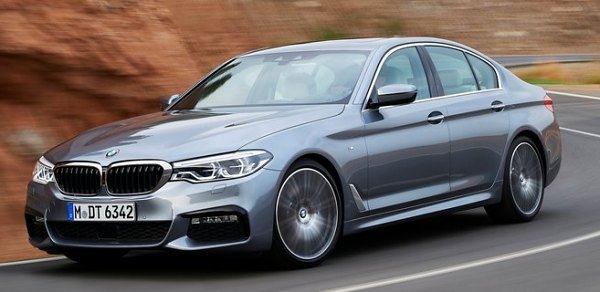 |
|
The
new 5er undercuts its predecessor by 55 to 105 kg. It is lighter than
even the all-aluminum Jaguar XF!
|
|
The range of
engines are not exactly new because most of them have been used in the
3 and 7-Series. They consist of the modular family B48 2-liter
4-cylinder, B58 3-liter 6-cylinder, B57 2-liter 4-cylinder diesel and
B57 3-liter 6-cylinder diesel, in addition to N63 4.4-liter V8. All
petrol engines feature direct injection, double Vanos, Valvetronic and
twin-scroll turbo. The diesel engines employ 2500-bar common-rail
injection and VTG turbocharger. 6-speed manual is still available to
smaller engines, but most cars should employ the carried-over 8-speed
ZF automatic, which is still the very best in the industry.
We always love the gasoline straight-six turbo for its smoothness,
free-revving manner and good power and torque. In the new 540i, its
output is increased to 340hp, taking 0-60 mph acceleration to less than
5 seconds, or even 4.6 seconds with the traction advantage of xDrive!
That was the performance level of M5 a couple of generations ago! The
new M550i xDrive with its 462hp V8 is even more astonishing, taking
only 3.9 seconds to finish the same sprint. Do we really need an M5?
Yes, we do, but before it arrives in a couple of years’ time, we should
have not much regret.
However, the best thing about BMW is that all its engines are good or
excellent, no matter the entry-level 520d or four-cylinder 530i, or the
plug-in hybrid 530e, or the mass-selling 530d six-cylinder diesel. They
provide good performance, refinement, fuel economy and emission without
resorting to tricks (unlike Audi). No one else in the industry has a
better powertrain lineup.

|
|
New
interior looks remarkably close to that of the 7-Series. The quality
and craftsmanship are finally on a par with Mercedes and Audi...
|
|
While it keeps the advantage in
powertrains, it has greatly closed the gap from rivals in interior
design and finishing. Now the interior looks remarkably close to that
of the 7-Series, which is a good news because it looks upmarket,
expensive and high-tech. While the dashboard design doesn’t break new
ground, it is reshaped to be sleeker and its center console more
oriented towards the driver. The quality of materials and craftsmanship
are finally a match to Mercedes and Audi, which is currently the
benchmark of the class. Moreover, the BMW has plenty of electronic
gadgets to play with. The updated i-Drive system offers a larger
(10.25-inch) free-standing display, and it is finally a touchscreen to
please those not akin to the rotary control knob on transmission
tunnel. Alternatively, it can recognize gesture or voice commands. The
new TFT instrument panel is clearer to read and its theme will change
according to driving modes. Benefited by the 7-Series, the 5er gets
countless of semi-autonomous driving aids, such as adaptive cruise
control with automatic lane change capability working up to 112 mph.
The cabin offers more space, too. Rear legroom is improved by 30mm,
while rear headroom is also more generous. As the outgoing car was
still roomy enough to match Mercedes E-class and Audi A6, the new car
is even more competitive. Seating comfort is also improved by new
seats. The front seats are more supportive for better comfort in long
drives. The rear bench seat is reshaped to better serve the middle
passenger. At the back, the boot is enlarged slightly to 530 liters.
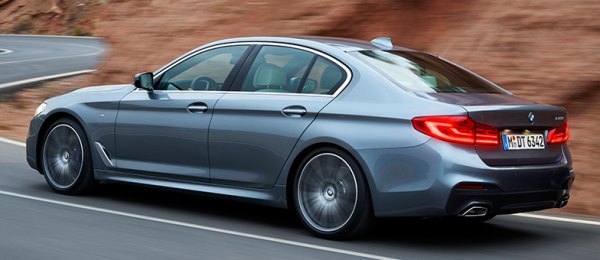 |
|
Benefited
by 4-wheel steering, it is unusually agile for a car of this size...
|
|
However, the
key question is still how it behaves on the road. The outgoing F10 was
dynamically accomplished, but its steering disappointed and its ride
not the best sorted. It was neither as comfortable as Mercedes E-class
nor as engaging to drive as Jaguar XF or Cadillac CTS. Thankfully, the
G30 is much better sorted. Take 540i for example, its powertrain is
close to perfection. Power delivery is creamy smooth yet responsive and
elastic. The ZF transmission shifts seamlessly yet quickly. The car is
so quick that you can’t believe it possess only 340 horsepower – it
seems that BMW’s 340 hp is more than Jaguar’s 380 hp.
Dial to Sport mode and the 540i gets more serious. Its steering loads
up, and its gear ratio is direct enough to give you reassuring
confidence. It is also a tad more communicative than the helm of F10,
even though it will never return to the level of E39. Slip into the
first corner, the 540i displays unusual agility for a car of this size.
The active rear-wheel steering plays an important role to sharpen its
handling, but even without it the new 5-Series is still more agile than
the old car, thanks to the new rear suspension and the stiffer chassis.
It feels light and very well balanced. The stiffened dampers provide
tight body control, and the tires afford generous grip. Is it sharper
to steer or better controlled than Jaguar XF? Probably not, but the gap
has largely narrowed.
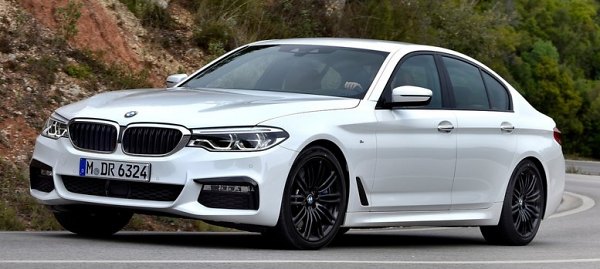 |
|
M550i
xDrive takes only 3.9 seconds to do 0-60 mph. Do we really need an M5?
|
|
More
surprising is how well it matches Mercedes E-class for comfort and
refinement in more relaxed driving modes. Apart from the smooth and
quiet straight-six, the suspension is also much better isolated from
road shocks and noise than the old car, which is quite an achievement
considering the lack of air springs. No matter high-speed bumps,
ripples, expansion joints or low-speed potholes, the new chassis deals
with much greater authority. In fact, it soaks up sharp bumps more
effortlessly than the air-sprung Mercedes. Wind noise is remarkably
low, too.
For pure driving, I suppose the Jaguar XF might still hold a slight
edge, but the BMW has unquestionably better powertrains and
performance, not to mention its far more convincing accommodation,
comfort, build quality and tech toys, overwhelming enough to guarantee
a higher ranking. What about the Mercedes E-class? It is handsome
outside and impeccable inside, but now the BMW has matched or even
surpassed it in running refinement, while handling and driver
engagement is on another level. This means, the 5-Series is once again
the car to beat in the class. Its next challenger will come from Audi,
but I suspect it won’t have much problem to keep its title for many
more years.
|
Verdict:      |
Published
on 21
Dec 2017
|
All rights reserved.
|
|
M5 (F90)
|
|
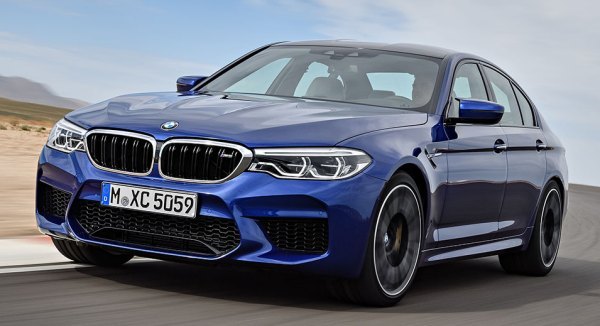
|
|
4WD
must be the hardest question to the M division since its abandoning of
naturally aspirated engines, but it has got the right answer.
|
|
Since its birth in 1984,
BMW M5 has been known as the benchmark of sports saloons. For many
years it consistently topped the crowd, but in the past 4 years we
reckoned Mercedes-AMG E63 S 4matic was the better car. In comparison,
the outgoing M5 was a bit tamed – too quiet, too slow and even not too
entertaining in handling. Most worrying, AMG showed that 4WD could be
lightning quick yet fun to drive. The new generation E63 S 4matic+ has
lifted the bar higher still with a 4WD system that can be switched to
RWD mode for rubber-burning power slide. BMW is facing the decisive
question: to follow the 4WD trend or not? If yes, will it damage the
traditional character
of M cars and disappoint its fans? If not, will it fall behind AMG even
further? This must be the hardest question to the M division since its
abandoning of naturally aspirated engines. Eventually, it decided to
take the challenge and move forward.
Strangely, the new M5 is referred F90 instead of the G30 codename of
the mass production 5-Series. This might imply more modifications than
ever, but in fact a comparison with the regular M550i will find the M5
remarkably close in specifications, such as a 4.4-liter twin-turbo V8,
an ZF 8-speed automatic (no more SMG dual-clutch!) and even a 4WD
system branded xDrive. The exterior differs little as well – the front
intakes are slightly larger, the exhaust becomes quad-pipes, and each
front fender sports a hot-air outlet. That’s all. There are not even
wider wheel arches, because the 5-Series body is already wide enough to
accommodate its 275- and 285-section front and rear tires. In the end,
you are more likely to spot the M5 by its gold brake calipers with
M-logo. Such is the understated manner of the car. It must be a good
candidate for stealth police cars.
Compared with the old M5, it doesn’t look too big a progress either.
The V8’s codename is S63B44T4, seemingly just a minor update from the
last S63B44Tu. It keeps the then-innovative hot-Vee architecture with
cross-bank turbocharging. Modifications are limited to higher fuel
injection pressure, improved cooling and lubrication system, revised
intake and exhaust, electronic waste gates and larger turbochargers
that raises boost pressure
from 1.5 to 1.7 bar, which is remarkably high for a production engine.
Disappointingly then, maximum output is improved by only 40 hp to 600
hp, which is no more than the last M5 fitted with Competition pack. It
still trails arch-rival E63 S by 12 ponies – a small but mind-blowing
difference. Torque is better, lifting from 501 to 553 lbft, and it is
available from 1800-5600 rpm. Mercedes-AMG makes 74 lbft more torque
still, but its torque band (2500-4500 rpm) is neither as wide nor
starts as low, primarily because it lacks the cross-bank turbocharging
technology but also due to its smaller capacity.

|
|
Cross-bank
turbocharging and larger capacity give the M-power V8 a healthier
torque spread than AMG's V8, even though it loses in peak figures.
|
|
The power advantage over the last M5 might be slim, but the new car has
its 0-60 mph sprint shortened by almost a second to 3.3 seconds,
leveling with the AMG! Unsurprisingly, this improvement is mainly down
to the addition of front-wheel traction. It is also a proof that the
latest torque converter automatic gearbox loses nothing in performance
to an average DCT. As before, the standard M5 is regulated at 155 mph,
but everyone will opt for the driver’s pack that lifts the restriction
to 190 mph, just enough to beat its Affalterbach rival.
However, by far the most important is the 4WD system called M xDrive.
Unlike the regular xDrive, it uses a multiplate clutch to engage the
front axle on demand. This means, in regular driving (without tire
slip), the M5 is predominantly rear-drive. When you accelerate too
hard, or the surface gets slippery, or you rush into corner, the system
will send some torque to the front axle to enhance traction and
stabilize the car. How much or how eager it does so depends on which
mode you select. The system offers 3 modes: 4WD, 4WD Sport and 2WD.
4WD Sport is more rear-biased than 4WD, while 2WD is purely rear-drive,
of course. And then the torque bias is also influenced by the stability
control setting, which has another 3 choices – normal, M Dynamic and
OFF. Coupling to 3 steering weightings, 3 transmission speeds, 3 engine
mappings and 3 suspension modes, you have many many combinations to
choose from. Fortunately, the M5 offers you 2 shortcut buttons, labeled
M1 and M2, on the steering wheel to save 2 of your favourite
combinations.
Instead of software things, I am more interested in the mechanical
side. Surprisingly, unlike the high-performance Audi or Porsche or
even AMG, the M5 is actually purer than its lesser siblings. While the
M550i can be equipped with active rear-wheel steering and active
anti-roll bars, the M5 has none of them, just adaptive dampers and
well-tuned suspensions. It might be right that 4WS could improve
agility, but the M5 already has a variable 4WD system and active M
differential for torque vectoring between the rear wheels, so 4WS is
not a must. Moreover, keeping it simple benefits weight. Even with the
additional 4WD hardware, the new car manages to cut 15 kg from the old
car. You might say 1855 kg DIN is by no means light, but look elsewhere
and you will find everybody else are heavier – 1875 kg for E63 S, 1950
kg for RS6 Performance or 1872 kg for the rear-drive Cadillac CTS-V.
This must thanks to the lighter construction of the new 5-Series donor.
Its front fenders are made of aluminum (as are the bonnet, boot lid and
doors, like the regular 5er), while the roof is changed to carbon-fiber
for the first time. A lighter lithium battery is used and it is placed
at the boot for improved weight distribution. In the chassis, there are
some additional reinforcement bracings at the engine compartment and
rear subframe.
 |
|
The
chassis of M5 is actually purer than its lesser siblings, without 4WS
or active anti-roll bars.
|
|
Most super sedans wear significantly wider footwear at the rear than
the front. Unusually, the new M5's rear rubbers are just 10mm wider.
This is encouraging, because the enhanced front-end grip in relation to
the rear should translate to a more neutral handling. We shall see
soon...
On the Road
Enter the roomy cabin, drop into the comfortable bucket seats and start
the
motor, you don’t take long to realize the difference between the M5 and
AMG E63: it is calmer and more refined. At town speed or normal
cruising, the M-power V8 is just as docile as any regular BMW V8.
It is quieter and its power delivery is smoother than the AMG V8. Even
in anger mode, it is probably too quiet for a car possessing 600
horsepower and capable of 0-60 in 3.3 ticks. The AMG’s exhaust howl and
crackles are
madder, which is more satisfying to our ears, but the M5 is no slower
in the real world – perhaps a tad quicker on track. Its turbo lag is
subtler, power delivery is more linear and therefore easier to deal
with. It works smoother with the gearbox and 4WD system. Yes, the AMG’s
noise and kick feel more dramatic and special, but the BMW powertrain
is actually a better companion for keen drivers, just like in the good
old
days when we preferred high-revving
naturally aspirated engines to heavily turbocharged ones. It is a very
versatile engine, quick to respond to throttle low down and eager to
rev to 7000 rpm.
The change to ZF automatic transmission presents no regret. It might be
very slightly slower than the best PDK in certain circumstances, but
the old SMG was never the best dual-clutch box, so it sacrifices
nothing. On the contrary, its smoother gearshift suits a large luxury
sports saloon like this.
While the new E63 S is known for a firm ride even in its softest
setting, the new M5 is far more comfortable. In Comfort mode, it is
nearly as supple and quiet as the regular 5er. Wind and road noises are
well suppressed, too. In fact, nothing in its class could quite match
its executive car manner. Even in sportier modes the suspension is
still quite absorbent and easily useable on most roads. It makes us
wonder why AMG’s air suspension could bring a worse result than BMW’s
steel springs and simpler adaptive dampers. Perhaps it is more about
the suspension kinetic design and fine tuning.
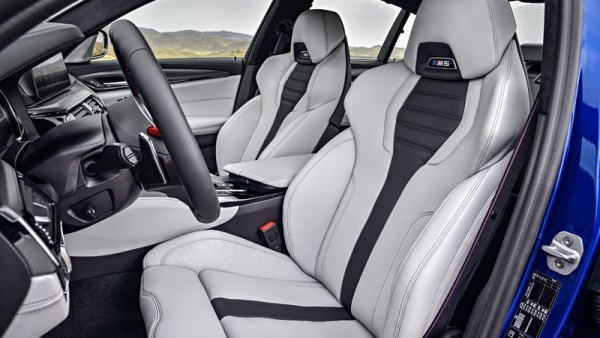
|
|
Fast
and luxury, nothing in this class bridges both worlds as well.
|
|
Turn into a corner, the variable-ratio rack is not rich of feel – just
like AMG or Audi, but it is precise and places the big car accurately
onto the desired line. Lacking an active anti-roll bar, it does roll a
bit in the twisty, but it feels natural and harms no confidence. Even
in 4WD mode, you can feel the car is driven by the rear wheels and it
corners with remarkably neutral attitude. Push it harder and you can
sense torque is directed forward to gain traction. Switch to 4WD Sport
and you can move the tail around a bit more. The oversteer gives you
another tool to adjust the line, but the stability control in M Dynamic
mode will keep watching and preventing from big slide, so it is
adjustable but safe. At this setting, the M5 feels agile yet confidence
inspiring. It can attack narrow back roads like an M3, something
unimaginable for a car so big and heavy.
Like AMG, the usage of 2WD mode is practically limited to a wide track
where you can find plenty of space and no traffic. Do so and the M5
will hold the power slide as long as you wish, just like a rear-drive
E39 M5. However, in the mode more relevant to road use, the BMW is more
fun than AMG, because you can switch the stability control completely
off in 4WD Sport, while on the AMG the electronic safety net is always
turned on (except in rear-drive mode). This means, oversteer and power
slide are more accessible on the M5 in real-world driving. Moreover,
the M5’s control strategy seems to integrate the M xDrive, ESP and
active M differential more in harmony, resulting in a smoother
transition from under to oversteer. All in all, the M5’s chassis feels
more agile, and more benign at the limit.
This means, although its V8 lacks aural appeal and its steering is not
as communicative as we wish, the new M5 is still clearly a better
driver’s car than the E63. On the other hand, if you are not in mood to
attack, you will enjoy the car’s supple ride, quiet cabin and good
refinement just as much as a lesser 5-Series. Such a versatile manner
makes it all the more appealing to the buyers in this class, because
hardcore drivers will always prefer the smaller M3 / C63 / RS4 etc.
After all, those choosing a car this class – we are not talking about
an E34 M5 of 30 years ago, which was 200 kg lighter and a class smaller
than today’s – should expect the dual personalities of being fast and
luxury. The M5 fits this expectation the best. It is not perfect, but
pretty close.
|
Verdict:      |
Published
on 19
Aug 2018
|
All rights reserved.
|
|
M5 Competition
|
|
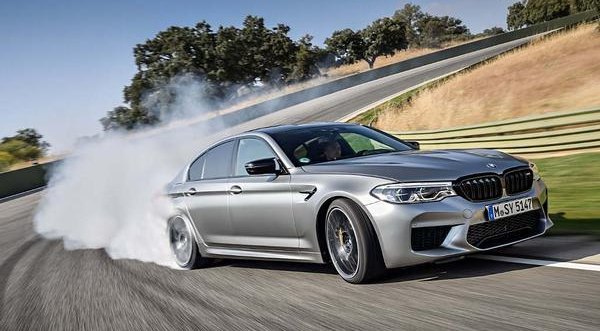
|
|
Subtle
changes they might sound, the result is a sharper and keener M5.
|
|
In the last generation M5,
Competition pack was offered in the final year as a stop-gap upgrade
and the last effort to keep the production line busy. Now BMW has
adjusted its strategy. From now on, Competition will be sold
permanently as a slightly hotter version of the standard M car. This is
just like the relationship between Mercedes-AMG E63 and E63 S. If you
want more comfort, stick with the M5. If you demand a tad more
performance and sharper handling, go for the M5 Competition.
Like the old M5 Competition pack but unlike the new M2 Competition, the
M5 Competition receives only subtle tuning to engine and chassis. The
bi-turbo V8 is 100% the same except a remapped ECU. This deliberates
its output by 25hp to 625hp, finally eclipsing E63 S – at the launch of
the M5, we were surprised that it trailed the 612hp E63 S a little. Now
we understand why. Maximum torque, however, remains unchanged at 553
lbft, no match for the AMG’s 627 lbft, although it is now available
across a slightly wider band.
Needless to say, in real world driving you will be hard pressed to tell
the extra grunt, which is only 4 percent more. Equally true is the 0-60
mph time of 3.2 seconds versus the previous 3.3 seconds. In fact, these
supersaloons have evolved to the state that any more performance would
be seen as irrelevant. Nevertheless, the Competition’s switchable sport
exhaust does produce louder and bassier music, and more aggressive
crackles on overrun, though not quite as wild as AMG.
Changes to the chassis is extensive but subtle. The engine mount is
stiffened by half. The suspension is lowered by 7mm accompanied with
10-percent stiffer springs, retuned adaptive dampers, stiffer rear
anti-roll bar, more negative front camber and fitting the rear toe
links with rigid ball joints instead of rubber bushings. Minor they
might sound, the summation of them results in a noticeable change in
character. The steering feels sharper (if still lack of true road feel)
and more precise. The nose bites harder and turn-in gets more
responsive. Although the big car never feels small on backroads, the
chassis mods make it keener to turn and flatter to corner than either
the standard M5 or its AMG rival. Meanwhile, the rear-biased 4WD system
remains remarkably neutral, and the wonderful power slide in RWD mode
is unaltered. Predictably, the only drawback is a stiffer ride, but the
loss of comfort is small. In Comfort mode the car still glides over
poor roads with ease, while Sport is borderline usable on most roads.
Cosmetically, the car is just the same as M5 except very minor details,
such as unique wheel design and door mirrors. To keen drivers, its 7
percent price bump is worthwhile.
|
Verdict:      |
Published
on 12
Sep 2021
|
All rights reserved.
|
|
M5 CS
|
|
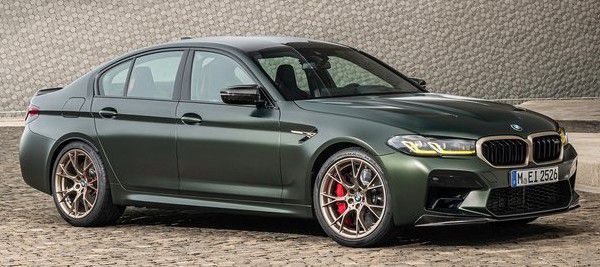
|
|
BMW
has improved the M5 again, this time even more successful than the last
Competition.
|
|
Just as M5 Competition is
never a competition car, M5 CS is not going to take part in any club
sport, but it should be the ultimate M5 in this generation. While the
regular M5 is priced at £89,000 and the Competition raises the
bar to £102,000, the CS tops out the range at £140,000.
That’s equivalent to an AMG GT63 S 4-door or the top Porsche Taycan
Turbo S. Is it that special?
Outside, the CS can be distinguished from lesser M5s by some subtle but
noticeable tweaks: bronze-colored double-kidney grille and forged alloy
wheels, carbon-fiber air vents, spoilers and door mirrors. Inside, it
gets deeply sculpted carbon-fiber bucket seats, 2 individual rear
buckets, red leather stitching, some carbon-fiber trims and shift
paddles and Alcantara-wrapping steering wheel. All look suitably
special.
The twin-turbo V8 gains only 10 horsepower at the top end. Maximum
torque remains at 553 pound-foot, although it lasts a further 150 rpm.
BMW did not detail the changes made to the engine, but we know it gets
improved intercoolers and lubrication system besides the usual ECU
tweaks. On the road, it feels more than the numbers suggested. Not only
freer at the top end but throttle response is more immediate. Rev rises
and falls precisely according to your control, without the elastic feel
of the previous versions. Moreover, a new stainless steel active
exhaust accompanied with less sound insulation results in a far more
exciting aural character. Under acceleration, you hear more induction
noise and more exhaust howl from the cabin, which is what the regular
M5 and Competition lack, even though AMG still masters the acoustic art
better.

|
|
Carbon
front buckets and individual rear buckets are part of the 70kg diet.
|
|
The CS also underwent a diet that claimed to cut 70kg, although its
kerb weight is actually 50kg less than the Competition. Carbon-fiber
bonnet, the aforementioned carbon seats, less sound deadening materials
and standard ceramic brakes contribute to the reduction. As a result,
the CS storms from rest to 60 mph in merely 2.9 seconds, faster than
any other internal combustion sedans.
The chassis is built on the Competition model, which already got
stiffer engine mounts, stiffer and lowered suspension as well as more
negative camber. The CS just need to stiffen its springs further and
retune its adaptive dampers to suit the reduced weight.
Don’t think its ride must suffer as a result. On the contrary, the CS
rides better than the regular car, let alone the rather stiff
Competition. The ceramic brakes, which save 23kg unsprung weight, must
be a crucial factor. Ditto the retuned damping. The CS feels calmer and
more tied down when pushed. Its rear axle is far less unsettled by
bumps on poor surfaces. As a result, it finds more grip and precision,
and you can push it harder corner after corner. The stiffened
suspension also improves the steering, making it more responsive and
more connected to the road. The entire car has a new found sense of
agility, control and engagement.

|
|
Sharper,
faster, calmer yet more comfortable. An engineering triumph.
|
|
Switch to Comfort mode and the CS becomes a comfortable cruiser. Not
quite as comfortable as a regular 5-Series, as you are always reminded
about the loss of sound insulation, while low-speed bumps can be more
easily felt. However, for a performance car at this level, the CS is
remarkably livable. It still gets all the classy infotainment and
comfort features of the 5-Series, not to mention a spacious cabin and
faultless build quality.
A more responsive and better sounding motor, a sportier and more
communicative chassis, a more comfortable ride and some nice visual
tweaks make the CS not only the best M5 of this generation, but also
the best value for money, even though £140,000 sounds a lot for a
5-Series.
|
Verdict:      |
|